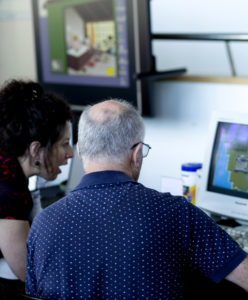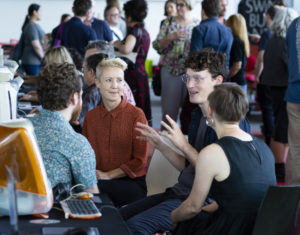February 10, 2023; Swinburne University. Visitors to SIDE-BY-SIDE played 1990s video games and interacted with media artworks from the same period, installed on original hardware and emulated using EaaSI. Inspired by the Guggenheim Museum’s curatorial concept of ‘seeing-double’, SIDE-BY-SIDE offered the opportunity to compare the experience and test out emulation as a strategy for preserving complex digital artefacts.

Cynde Moya, Postdoctoral Fellow at Swinburne’s Digital Media Heritage Lab, assembled the original vintage hardware; prepared works on obsolete digital carriers for emulation; and configured the EaaSI environments.
Six media artworks – Norie Neumark and Maria Miranda’s Shock in the Ear (1998), Michael Buckley’s The Good Cook (1998), Felix Hude’s Haiku Dada (1993), John Collette’s 30 Words for the City (1995), Linda Dement’s Cyberflesh Girlmonster (1995), and Martine Corompt’s Cute Machine (1998) – were shown on hardware running Mac OS9 alongside their emulation in EaaSI running Sheepshaver.

The installation of Norie Neumark and Maria Miranda’s Shock in the Ear (1998) installed for SIDE-BY-SIDE.
Four Australian games were showcased: Beam Software’s Nintendo Gameboy title “Choplifter” was shown alongside the emulation running Virtual Boy Advance; the Windows 98 game “Warlords III: Darklords Rising” (1998), developed by Strategic Studies Group (SSG) and published by Red Orb Rising, with its emulation in QEmu; and “Krazy Ivan” developed by Psygnosis (1995), running in Windows 98 SE. These games have been collected by ACMI, a partner organisation in the Play It Again and AAMA research projects. Visitors can play selected emulated games from this project on-site at ACMI, either on fixed hardware in the “Story of the Moving Image” exhibition, or on their own devices when they connect to ACMI’s wifi. The list of games available for play is here.

Roger Keating and Barbara Lemon play Warlords III: Darklords Rising, a videogame created by Keating’s company in 1998.
The showcase was followed by a reception to launch The Australian Emulation Network: Accessing Born Digital Cultural Collections LIEF project. Funded under the Australian Government’s Linkage Infrastructure, Equipment and Facilities (LIEF) Scheme, the Australian Emulation Network is a large consortium including Australian universities, GLAM institutions, infrastructure partners AARNet and OpenSLX, and collaborators at Yale University, who have led the North American rollout of EaaSI.

Melanie Swalwell introducing the aims and focus of The Australian Emulation Network: Born Digital Cultural Collections Access LIEF project.
Melanie Swalwell gave a comprehensive overview of the project, its participants and aims. The AusEaaSI project will: stabilise high value cultural collections from university archives and the GLAM sector requiring legacy computer environments; provide researchers with emulated access to born digital cultural artefacts; share legacy computer environments across the network; and establish an Australian software preservation community of practice, building skills in preserving and emulating digital cultural artefacts. James Verdon, Swinburne’s Dean, School of Social Sciences, Media, Film and Education, officially launched the Australian Emulation Network project, remarking on the importance of investing in research infrastructure and expressing excitement at the breadth of the project.
Carolyn Murphy, Head of Conservation at the Art Gallery of NSW (AGNSW) and Candice Cranmer, ACMI’s Time-based Media Art and AV Conservator, spoke about AGNSW and ACMI’s long-term plans for preserving and providing access to their digital collections. Adam Bell, AARNet’s Galleries, Archives, Libraries and Museums (GLAM) Relations lead, explained that AARNet’s provision of the infrastructure underpinning this national-scale platform will provide capabilities in digital preservation for the future benefit of all Australian organisations, researchers, and members of the public.
Artists, researchers, colleagues and interested members of the public from interstate, New Zealand, Germany and the United States, who were unable to attend SIDE-BY-SIDE in person, accessed a live stream of the presentations.
Recording of SIDE-BY-SIDE
Acknowledgements and credits: Jonathan Lang and Jose Sanchex Huertz, Academic Operations Unit, School of Social Sciences, Media, Film and Education & School of Design and Architecture (streaming and videography). Sarah Cornwill (Photography)


